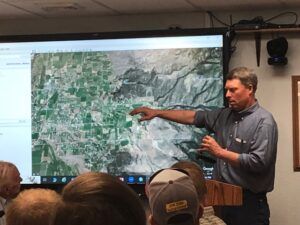
by Nathan Boddy
The Ravalli County Planning Board had a full room on Wednesday, May 3rd during their regular meeting. The board’s number one agenda item was the consideration of a proposed new major subdivision called Sapphire Heights, which would see the creation of 12 new lots at the far eastern end of Hamilton Heights Road.
The proposal, which was submitted to the Ravalli County Planning Department by Robert James and Stephen Foley, was represented by WGM Group, Inc. of Missoula. Under that proposal, the 12 new lots would range in size from 5.19 acres to 18.83 acres. Ten of the new lots would be north of Hamilton Heights Road, while the remaining two would lie to the south. The 10 lots on the north side of Hamilton Heights Road would require the creation of a new access road directly opposite Charley Gulch Road, as well as two spur roads to serve all 10 lots. The remaining two southern lots would each derive access directly onto Hamilton Heights Road.
Jacob Cummings, the case planner for the Ravalli County Planning Department, gave a presentation on the proposal which outlined the criterion used to measure a proposal’s suitability. Compliance with a variety of county prerequisites, including easements, access, and access to water rights, were considered. Other criteria measured by the planning department included seven points as outlined in the Montana Subdivision and Platting Act (MSPA), which included consideration of impact upon agriculture, local services, the natural environment, and habitat, as well as others. The recommendation of the Ravalli County Planning Department was that the 12-lot subdivision be “conditionally approved,” based on the findings of fact in the staff report.
Following a presentation by Jeff Standaert of WGM, Planning Board member Penny Howe-Canton opened the meeting to public comment. Due to the large gathering, she also acknowledged that the meeting was likely to run over the allotted time, in which case the board might consider a continuation.
During the public comment period, over a dozen people took to the microphone to express their opposition to the subdivision proposal. Concerns ranged from traffic safety to elk habitat, with many adjacent landowners doubting the findings on water availability as presented by WGM.
Andy Maki, a nearby resident, spoke at length about the history of agricultural lands in the area, and the importance of the connectivity of many of the remaining agricultural parcels.
“If you’re going to protect anything in the valley, I think you need to protect this,” said Maki. He also pointed out that, since the parcels are clustered to the far eastern edge of the valley and adjacent to the Calf Creek Wildlife Management Area and Forest Service, “it’s exceptional wildlife habitat. All this area is still intact and we’re just going to carve it up right in the middle?”
Even more than wildlife, however, Maki’s concerns, as well as for many other speakers, were focused on water. Maki said that his family’s water rights date back to 1860, but that the diversion to it is lower than that of the proposed new lots.
“If we get 30 new lot owners there, they’re going to take our water even though we’re entitled to it,” said Maki. “We’re going to spend all our time in court just fighting trying to get (the) water.”
Like other speakers, Maki also doubted the findings by WGM in regards to the amount of water available through wells. “Wells in this area are 1-2 gallons per minute,” further casting doubt on the ability for new lots to pump adequate water. “Everything in this development process is really, really vague,” he said.
The meeting became tense when one member of the public pressed WGM representative Jeff Standaert for answers as to why their study on impacts to wildlife made no mention of elk. Directing her questions at him, she drilled him for answers as to when a more adequate and finished study would be accomplished. His response, apparently unsatisfactory, soon caused multiple people in the room to loudly weigh in with their opinions as to the specific locations of elk in the area.
Board member Howe-Canton tried to calm the group by recommending that anyone with more detailed information should bring it forward to add to the public record so that the Department of Environmental Quality could make their decision. She also pointed out the meeting would definitely be continued in order for board members to make their own deliberations.
“And then you still have until the Commissioners’ meeting,” she said, “because the Commissioners have the final say.”
Ultimately, the meeting was continued until Wednesday, May 10th at 6 p.m.
Helen Sabin says
From where is the WATER to build these homes, irrigate the land and perhaps animals and allow them to be farmed, or used coming from? Please explain. With all the new building going on, our water sources will be stressed worse than they are now. Wells won’t handle the water needs and will reduce water to other well users in times of droughts. I say NO to these developments.